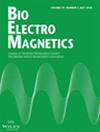Nathan Bala, Rodney J. Croft, Robert L. McIntosh, Steve Iskra, John V. Frankland, Raymond J. McKenzie, Chao Deng
下载PDF
{"title":"Characterization of the Core Temperature Response of Free-Moving Rats to 1.95 GHz Electromagnetic Fields","authors":"Nathan Bala, Rodney J. Croft, Robert L. McIntosh, Steve Iskra, John V. Frankland, Raymond J. McKenzie, Chao Deng","doi":"10.1002/bem.70013","DOIUrl":null,"url":null,"abstract":"<p>The present study investigated the core body temperature (CBT) response of free-moving adult male and female Sprague Dawley rats, during and following a 3-h exposure to 1.95 GHz radiofrequency electromagnetic fields (RF-EMFs) within custom-built reverberation chambers, using temperature capsules implanted within the intraperitoneal cavity and data transmitted via radiotelemetry. Comparing RF-EMF exposures (at Whole-Body Average-Specific Absorption Rate [WBA-SAR] levels of 0.1, 0.4, and 4 W/kg) to the sham exposed condition, we identified a statistically significant peak increase in CBT after 26 min of RF-EMF exposure at 4 W/kg (+0.49°C), but not in the 0.1 or 0.4 W/kg conditions at the same timepoint. In the last 30 min of the RF-EMF exposure, temperature was significantly increased in both the 4 W/kg (0.62°C) and 0.4 W/kg (0.14°C) conditions, but not 0.1 W/kg, when compared to sham. After 20 min following cessation of exposure, post temperature was still significantly higher in the 4 W/kg condition when compared to the sham (0.37°C), but not in either 0.1 or 0.4 W/kg. Based on our findings, it is apparent that rats can effectively compensate for increased thermal loads of up to 4 W/kg as the maximum temperature rise was substantially lower than 1°C. In addition, the elevated CBT during exposure in the 4 W/kg condition was significantly reduced immediately after exposure cessation, indicating that measures of CBT following RF-EMF exposure cessation may not reflect maximum RF-EMF-mediated changes in the CBT of rats. Bioelectromagnetics. 00:00–00, 2025. © 2025 Bioelectromagnetics Society.</p>","PeriodicalId":8956,"journal":{"name":"Bioelectromagnetics","volume":"46 5","pages":""},"PeriodicalIF":1.2000,"publicationDate":"2025-06-26","publicationTypes":"Journal Article","fieldsOfStudy":null,"isOpenAccess":false,"openAccessPdf":"https://onlinelibrary.wiley.com/doi/epdf/10.1002/bem.70013","citationCount":"0","resultStr":null,"platform":"Semanticscholar","paperid":null,"PeriodicalName":"Bioelectromagnetics","FirstCategoryId":"99","ListUrlMain":"https://onlinelibrary.wiley.com/doi/10.1002/bem.70013","RegionNum":3,"RegionCategory":"生物学","ArticlePicture":[],"TitleCN":null,"AbstractTextCN":null,"PMCID":null,"EPubDate":"","PubModel":"","JCR":"Q3","JCRName":"BIOLOGY","Score":null,"Total":0}
引用次数: 0
引用
批量引用
Abstract
The present study investigated the core body temperature (CBT) response of free-moving adult male and female Sprague Dawley rats, during and following a 3-h exposure to 1.95 GHz radiofrequency electromagnetic fields (RF-EMFs) within custom-built reverberation chambers, using temperature capsules implanted within the intraperitoneal cavity and data transmitted via radiotelemetry. Comparing RF-EMF exposures (at Whole-Body Average-Specific Absorption Rate [WBA-SAR] levels of 0.1, 0.4, and 4 W/kg) to the sham exposed condition, we identified a statistically significant peak increase in CBT after 26 min of RF-EMF exposure at 4 W/kg (+0.49°C), but not in the 0.1 or 0.4 W/kg conditions at the same timepoint. In the last 30 min of the RF-EMF exposure, temperature was significantly increased in both the 4 W/kg (0.62°C) and 0.4 W/kg (0.14°C) conditions, but not 0.1 W/kg, when compared to sham. After 20 min following cessation of exposure, post temperature was still significantly higher in the 4 W/kg condition when compared to the sham (0.37°C), but not in either 0.1 or 0.4 W/kg. Based on our findings, it is apparent that rats can effectively compensate for increased thermal loads of up to 4 W/kg as the maximum temperature rise was substantially lower than 1°C. In addition, the elevated CBT during exposure in the 4 W/kg condition was significantly reduced immediately after exposure cessation, indicating that measures of CBT following RF-EMF exposure cessation may not reflect maximum RF-EMF-mediated changes in the CBT of rats. Bioelectromagnetics. 00:00–00, 2025. © 2025 Bioelectromagnetics Society.
自由运动大鼠对1.95 GHz电磁场的核心温度响应特性
本研究调查了自由活动的成年雄性和雌性Sprague Dawley大鼠的核心体温(CBT)反应,在定制的回响室内暴露于1.95 GHz射频电磁场(RF-EMFs) 3小时期间和之后,使用植入腹腔内的温度胶囊和通过无线电遥测传输数据。将RF-EMF暴露(全身平均比吸收率[WBA-SAR]水平为0.1、0.4和4 W/kg)与假暴露条件进行比较,我们发现在4 W/kg(+0.49°C)的RF-EMF暴露26分钟后,CBT的峰值增加具有统计学意义,但在同一时间点的0.1或0.4 W/kg条件下则没有。在RF-EMF暴露的最后30分钟,与假手术相比,4 W/kg(0.62°C)和0.4 W/kg(0.14°C)条件下的温度均显著升高,但0.1 W/kg的温度没有升高。在停止暴露20分钟后,与假手术(0.37°C)相比,4 W/kg条件下的后温度仍显着高于假手术(0.37°C),但在0.1或0.4 W/kg条件下均没有。根据我们的研究结果,很明显,当最大温度升高大大低于1°C时,大鼠可以有效地补偿高达4 W/kg的增加热负荷。此外,在4 W/kg条件下暴露期间升高的CBT在暴露停止后立即显着降低,这表明RF-EMF暴露停止后的CBT测量可能无法反映RF-EMF介导的大鼠CBT的最大变化。生物电磁学。00:00 - 00,2025。©2025生物电磁学学会。
本文章由计算机程序翻译,如有差异,请以英文原文为准。


 求助内容:
求助内容: 应助结果提醒方式:
应助结果提醒方式:


